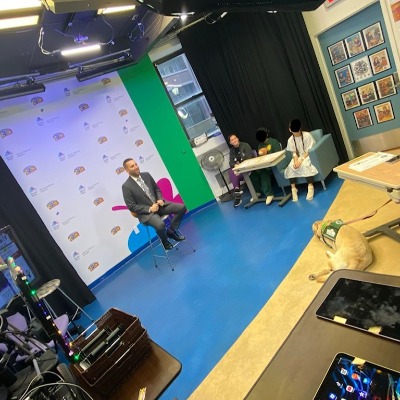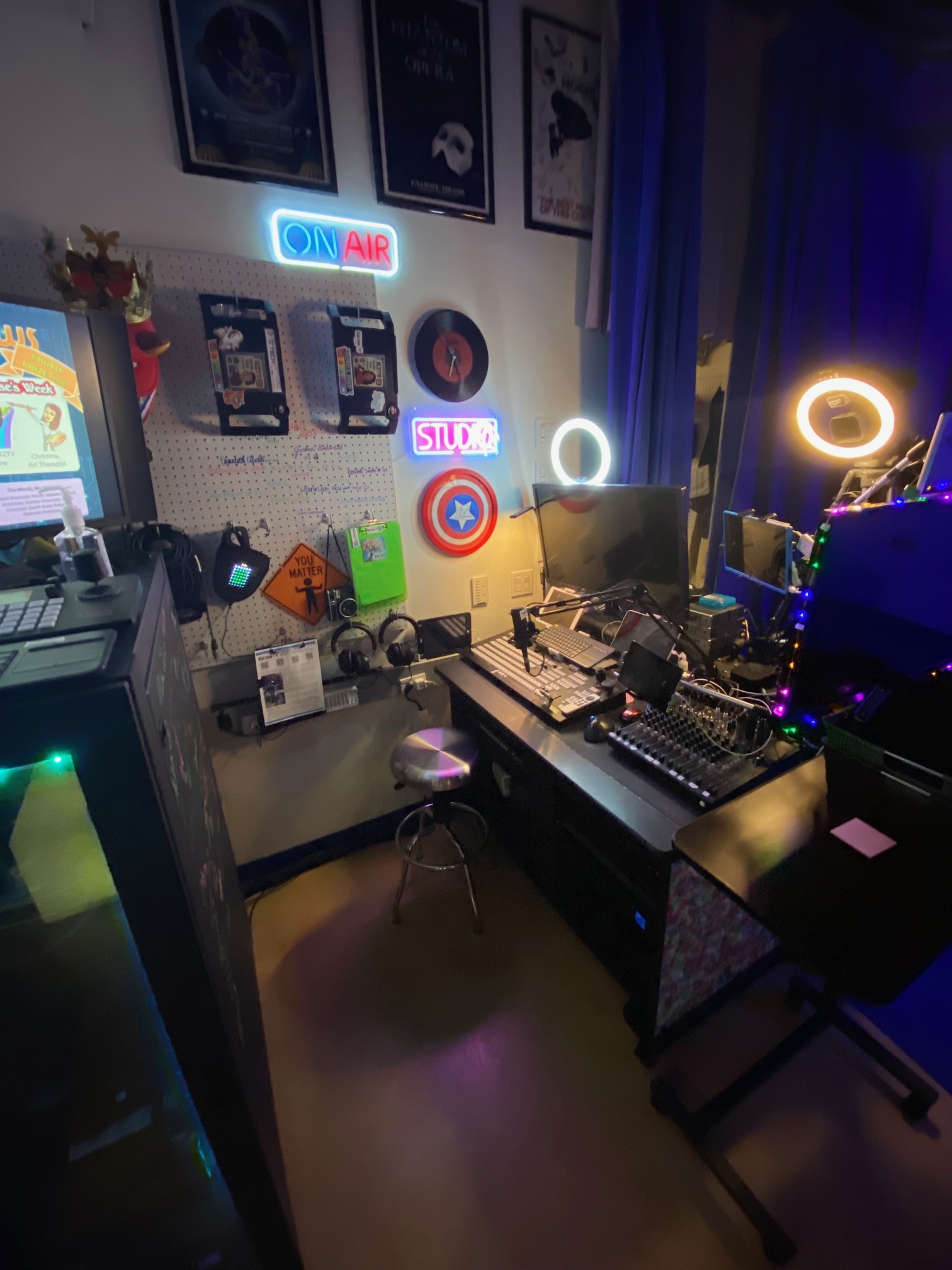.png?sfvrsn=d81a7f4c_1)
Luis Borges
Luis Borges is the Production Supervisor of KidZone TV at Mount Sinai Kravis Children’s Hospital, home to one of the nation’s most clinically integrated pediatric CCTV studios grounded in child life practice. The KZTV team partners with Child Life Specialists and Creative Arts Therapists to create live programming that strengthens patient agency, clinical engagement, and meaningful connection.

A young boy sits up in the chair next to his hospital bed, his father beside him, encouraging him on. He’s laughing along with his team in a room he hasn’t left in three days. On the screen across from him, a live show begins, and when he hears his name read aloud, he beams. “That’s me,” he says. “Yes, mijo,” his father replies. And it is. This is KidZone TV.
At the entrance to Mount Sinai Kravis Children’s Hospital, there’s something few people expect to find: a television studio. Beyond the lobby glass wall is the KidZone TV studio, a space where patients can heal, create, express, and feel empowered during hospitalization.
KidZone TV (KZTV) is more than entertainment; it’s a therapeutic tool co-designed with Certified Child Life Specialists (CCLSs). As pediatric settings adopt more video-based technologies, clinical intentionality is essential. With KZTV, producers align programming to clinicians’ goals, and each broadcast supports creativity, co-regulation, and connection. The studio is a flexible, consistently available tool, and adaptable to each child and moment.
How It Works: Co-Viewing & Open Studio
Through practices like co-viewing, when CCLSs or other clinicians watch and engage with a KidZone TV show alongside a patient, and open studio, when patients join as a live audience and participate at their own pace, CCLSs can turn any broadcast into play and connection. Each show is designed with moments that invite laughter, reflection, and expression. Producers collaborate with CCLSs, Music Therapists, Art Therapists, and others to identify patients who may benefit from intentional co-viewing. The clinical host weaves personalized engagement into the program, while the co-viewer reinforces it at bedside to guide low-pressure participation. In reflective segments like “Sticker Stories,” the co-viewing clinician helps the patient choose and submit meaningful images, and the host responds on-air to affirm and explore the child’s perspective. In each show, intentional co-viewing transforms a broadcast from something watched into something shared and shaped with the child, advancing patient-centered therapeutic goals.

Impact: Participation, Voice, and Community
Since 2006, KZTV has averaged 7,500 meaningful pediatric interactions each year, ranging from live broadcasts and bedside co-viewing to patient-led productions. A child might text a story, co-host a game show, see their drawing on air, or simply hear their name read aloud by someone they recognize. For families, these moments can mark a shift. As art therapist Chloe noted after a caregiver sent in a prom photo: it was the first time all week the caregiver focused on something other than illness: “Although the caregivers aren’t the patients, this show allows them to still feel supported while coping.”
Each show is intentionally structured to offer multiple entry points for participation. Whether reflecting on creations with clinicians or texting in poems from their rooms, patients are supported by a small, tightly coordinated producer team: Lu, Grace, and Martha, who run seven days of programming, mentor volunteers, and help clinicians create studio-ready content.
“Flexibility is key in the studio,” Grace said. “We coordinate with many people to make an open studio and patient-hosted shows happen.” Lu focuses on deepening impact by mentoring staff and clinicians to sustain KZTV’s therapeutic vision: “We’re not just running shows—we’re building clinical, emotional, and creative structures for patients and families to step into and feel held.” Martha added, “My favorite is seeing kids take ownership of projects or activities with KidZone TV, whether from their rooms or the studio.”
Kathleen, a CCLS and the studio’s most active clinical co-viewer, echoed that spirit of collaboration. “The KZTV team is the most flexible crew I have ever worked with. When you walk into the studio with a patient, the energy radiates from the team. They always support my ideas and my patients’ ideas as well.”
She described how co-viewing lets her build bonds and promote joy. “I co-view daily at the bedside to build connection, create joy, and support coping in ways that feel natural to the child.” She often includes everyone present, caregivers, siblings, nurses, and even doctors. “I’ve had multiple co-views where the nurses, doctors, and teachers join in. It helps build rapport across the interdisciplinary team. When a patient won her first Bingo, we all cheered and she jumped up and down; it was a huge party. That’s the power of KZTV: It brings the whole room, and interdisciplinary team, together.”
KidZone TV producers model attuned listening, responsiveness, centering each child’s narrative. Cues from a child’s energy or from a clinician’s therapeutic goals becomes part of a shared rhythm that positions the child as the author of the moment. “Grace knows what our shared patients like when they’re in the studio,” Kyla said. “That helps me create shows they’ll actually want to watch and join.”
Abbey, a Hematology/Oncology CCLS, called co-viewing transformative. “The studio helps kids feel seen, valued, and centered in an environment that’s often intimidating. I’ve used it for medical education, distraction, and community-building.” She recalled a personalized bingo show episode featuring several hospitalized friends: “I co-viewed one patient while others called in to say hi. It was special to see a group of young girls so deeply bonded and interacting almost entirely virtually.”
On the IBD service, Sarah, CCLS, described a long-term teen patient who reached “a state of flow” during gaming shows. “Their minds are completely focused on their show, drawing their focus away from their stressors and pain.” These moments build confidence and open space for connection. “I have witnessed true friendships between patients develop in that space.”
In “Art History with Katherine”, an art therapist introduced the work of Frida Kahlo and invited symbolic self-portraits of patients and caregivers. During the session, a mother texted in a photo of her artwork, sharing that it was the first creative act she’d done in weeks.
That sense of visibility, of being known and understood, is one of the studio’s most powerful impacts, especially for teens. KZTV’s mature programming, digital tools, and flexible hosting roles allow teens to engage on their terms. Options like digital art, virtual reality, and media editing align with adolescent identity. “Sometimes the right opening for a teen is not to ask them to talk about how they’re feeling,” Lu said, “but to hand them a controller, a camera, or access to a 3D printer, and say: Show me.”
Participation takes many forms. A young patient might help design a trivia game. A parent might share a poem. A long-term patient might become a director, working with staff to create their own edited video about something they love. “Behind the scenes is my favorite part,” said Noah, a young patient producer, “It takes your mind away from your pain.”
Volunteers and interns also find co-viewing powerful. Krista, now a college volunteer, and former patient and KZTV viewer, recalled helping a hesitant child co-host Bingo. “His dad thanked me afterward. That stuck with me.” Returning to the studio felt “full-circle.”

Getting Started (With or Without a Studio)
For CCLSs integrating programming, start small: choose one show each week to co-view intentionally with a patient. Treat the shared watching as an intervention-- stay present, follow cues, and use reflective, creative segments to build identity and confidence without requiring a child to speak about their feelings directly.
Even in settings without a dedicated studio, the core principles still apply. A tablet on a stand and a quiet room can create a moment of authorship. Recording short “strength messages” -- patients sharing encouragement or reflection, helps children see their stories and voices have value beyond their room.
The space itself is doing quiet work. The studio is not just a backdrop, its design, lighting, and materials promote emotional safety, offering structure and spontaneity. At its core, the studio is the network of collaboration, shared moments of co-viewing that bring patients, caregivers, and staff together. The heart of KZTV is the community that builds it every day: patients who lend their voices, the CCLSs who show up, and producers who keep everything flowing. As one CCLS put it, “Our studio, and our producers, change the associations children have with the hospital. They excel at amplifying patient voices and supporting their interests through KZTV.”
KidZone TV doesn’t replace clinical care; it extends it. Through voice, vision, and a room that holds space for creative authorship, patients leave something that can inspire others – a reminder that their presence, perspective, and story matter.

